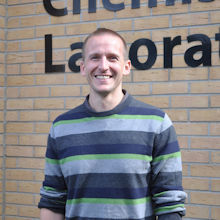Dr Pete Edwards
Phone: 01904 321217
Email: pete.edwards@york.ac.uk
Independent Research Fellow
Pete is an associate professor in the Wolfson Atmospheric Chemistry Labs and the UK National Centre for Atmospheric Science. As an atmospheric chemist Pete's research focuses on the complex processes that breakdown chemicals emitted into our atmosphere, and ultimately control global challenges such as air pollution and climate change. Pete works across the major sub-disciplines of the field, from instrument development, through laboratory and field experiments, the use of chemical models to challenge and improve our understanding of atmospheric chemical phenomena.
Research interests
Climate change and air quality are two of the major challenges facing modern society, and these are both directly impacted by the chemistry of the lowest part of the atmosphere, the troposphere. My research focuses on improving our understanding of the processes that control the chemical composition of the troposphere, especially those driven by highly reactive species known as radicals. This is achieved through novel instrument development, field observations and the use of computational models. Combining field observations with computational modelling allows us to test and advance our understanding of the processes controlling key atmospheric species, improving our ability to provide sound advice to policy makers on future scenarios for both air quality and climate change.
A major focus of the work in my group is the development of new analytical techniques for the detection of important atmospheric trace gases. This includes novel instruments to probe the importance of atomic chlorine as a tropospheric radical, funded through the European Research Council, and novel laser induced fluorescence instruments for the sensitive detection of important species such as sulfur dioxide and nitric oxide. I also have a keen interest in enabling the potential of low-cost sensors for air pollution research and monitoring. With ongoing projects in both the UK, working closely with the Department for Environment and Rural Affairs (Defra) and other UK collaborators, and several West African nations.
Career summary
Prior to moving to York Pete worked at two of the world’s leading atmospheric research institutions, in the UK and the USA. Pete’s PhD was carried out with Prof. Dwayne Heard, in the School of Chemistry at the University of Leeds, and focused on the chemistry of the dominant tropospheric oxidant, the hydroxyl radical (OH). This involved developing and deploying laser induced fluorescence instruments in a range of different environments for the measurement of OH concentrations and OH loss rate (also known as OH reactivity). This work resulted in 9 publications and multiple presentations at international conferences, as well as his selection to attend the prestigious biannual Atmospheric Chemistry Colloquium for Emerging Senior Scientists in the US in 2011.
Following his PhD Pete took up a postdoctoral position with Dr Steven Brown in the Chemical Sciences Division at the National Oceanic Atmospheric Administration’s (NOAA) Earth System Research Laboratory in Boulder, Colorado. At NOAA Pete expanded his experience in the development of sensitive spectroscopic instrumentation, in particular in the application of cavity ring-down spectroscopy to detect oxides of nitrogen. Pete also continued to combine field observations with model analysis to address important challenges in the field of atmospheric chemistry. A major focus of this work was his analysis that identified the unusual photochemistry driving previously unexplained winter ozone pollution events in regions of extensive oil and gas extraction in the western US. This work resulted in multiple publications, including a first author paper in Nature, and was awarded both the 2014 ‘Colorado Governor's Award for High- Impact Research’ and the 2016 ‘NOAA Ocean and Atmospheric Research Outstanding Scientific Paper’ Award.
Pete moved to York in 2014 and took up a Marie Skłodowska-Curie Reintegration Fellowship, which focused on the development of new applications of low-cost sensor technologies in atmospheric research. He also worked with Prof. Mat Evans developing a new chemical diagnostic for the global chemical transport model GEOS-Chem. In 2018 Pete was awarded a €1.7M European Research Council (ERC) starting grant to develop novel observational techniques that will ultimately improve our understanding of the role of atomic chlorine as a tropospheric oxidant. In addition to several other projects, including the development of laser-induced fluorescence instruments for ppt level detection of sulfur dioxide and nitric oxide, Pete was the PI of the UKRI Strategic Priorities Fund collaborative project QUANT (£1.2M) which aimed to enable the use of low-cost sensors for air pollution monitoring in UK urban environments.
Selected publications
- Halfacre, J. W., et al.: Using tunable infrared laser direct absorption spectroscopy for ambient hydrogen chloride detection: HCl-TILDAS, Atmos. Meas. Tech. 16, 5, 1407-1429, 2023.
- Diez, S., et al.:, Air pollution measurement errors: is your data fit for purpose?, Atmos. Meas. Tech. 15, 13, 4091-4105, 2022.
- Hamilton, J., et al.: Key role of NO3 radicals in the production of isoprene nitrates and nitrooxyorganosulfates in Beijing, Environ. Sci. Technol. 55, 2, p. 842–853, 2021.
- Womack, C. C., et al.: An odd oxygen framework for wintertime ammonium nitrate aerosol pollution in urban areas: NOx and VOC control as mitigation strategies, Geophys. Res. Lett., 2019.
- Edwards P. M. , et al.: Transition from high- to low-NOx control of night-time oxidation in the south-eastern U.S., Nature Geoscience, 10, 490-495, 2017.
- Edwards, P. M. and Evans, M. J.: A new diagnostic for tropospheric ozone production, Atmos. Chem. Phys., 17, 13669–13680, 2017.
- Lewis, A. C. and Edwards P. M.: Validate personal air-pollution sensors, Nature, 535, 29-3, 2016.
- Edwards, P. M., et al.: High Winter Ozone Generated by Carbonyl Photolysis in a Shale Gas and Oil Producing Region. Nature. 514, 351-354, 2014.
- Young. C. J., et al.: Chlorine as a primary radical: evaluation of methods to understand its role in initiation of oxidative cycles. Atmos. Chem. Phys., 14, 3427-3440, 2014.

